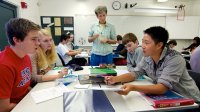Comprehensive Assessment Research Review: Avoiding Pitfalls
Avoid these common mistakes so you can help ensure a comprehensive assessment process that is effective for both you and your students.
Your content has been saved!
Go to My Saved Content.Below are some common pitfalls that can reduce the efficacy of assessments along with suggestions for how to avoid these issues.
Failing to Make Assessments Accessible to All Learners
Assessments that have not been normalized for English-language learners may measure both language proficiency and content knowledge, making it difficult for educators to determine whether an English-language student has difficulty with language or content (Alvarez & Corn, 2008). To generate a more reliable assessment, teachers must be aware that English-language learners have a complex set of language and literacy needs. To learn more about assessment practices that work for English-language learners, see the resources provided by the Educational Testing Service and educational sites such as ¡Colorín Colorado!.
To reduce barriers to accurately measuring the knowledge, skills, and engagement of learners with diverse needs, assessments should also provide multiple means of representation, expression, and engagement to optimize choice, autonomy, relevance, value, and authenticity. The National Center on Universal Design for Learning provides research-based guidelines, and the National Center on Accessible Instructional Materials provides many resources to help make instructional materials more accessible.
Not Allowing Time to Try New Assessment Approaches
Teachers can feel overwhelmed by the prospect of having to design a personalized curriculum for each student. But planning for differentiated or personalized instruction does not necessarily take more time than planning for traditional, whole-class curriculum; it requires a different approach, however, that allows for greater flexibility and student autonomy. Once planning is complete, teachers often find that differentiated instruction removes the pressure of conducting an entire class on their own and that engaging with students becomes easier and more rewarding.
Teachers also may become frustrated if they do not experience early successes with differentiated instruction. Sustained effort and professional supports to provide feedback and coaching are necessary to support their success.
Not Providing Adequate Support for Teachers’ Growth
Assessment reform is a long-term endeavor that cannot be achieved through single or sporadic workshops. Teachers who participate in ongoing, sustained professional development with follow-up meetings, as opposed to one-day professional-development workshops, develop a better understanding of what authentic assessment entails and how to design rubrics to evaluate student work (Koh, 2011).
Koh (2011) recommends teachers use student work in meetings to examine and reflect upon the association between teaching and student learning. Teachers who analyze student work to reach a common understanding of valid assessments will be better able to have discussions about what teaching strategies can promote learning (Black et al., 2010). Such activities help teachers gain a greater sense of authentic assessment as well as a better understanding of the most-effective instructional choices.
Grouping Students Inflexibly
Teachers need to actively reevaluate students’ levels and coach them toward higher-level groups. The potential for growth should never be limited by low expectations.
Not Developing a Clear Vision for Classroom Management
“Leading people involves asking students to consider what it feels like when the classroom doesn't work for them or for their friends, to envision what a classroom would be like if it functioned in a way that helped each student grow as far and fast as possible -- and to participate in developing that kind of classroom,” says Carol Ann Tomlinson, University of Virginia Curry School of Education’s William Clay Parrish Jr. Professor and Chair of Educational Leadership, Foundations, and Policy, in an interview in the February 2011 edition of Curry Magazine.
“When you go into a classroom where teachers lead kids in that way, management is not the problem we tend to think it is because kids feel empowered and interested and invigorated,” she continues. “Still, however, there is the need to make sure the room doesn’t get too noisy or that the materials aren’t all over the place when students leave. There are plenty of details that need managing, but when teachers do that in the context of leading their students to help create a more effective place to learn, handling the details works much more smoothly and naturally.”
Letting Learners See the Answers Before Trying to Solve Problems on Their Own
According to Shute’s (2008) review, the benefits of feedback are much less likely to apply if learners have access in advance to the answers to the problems with which they are grappling. Try designing questions with multiple possible answers, or try changing up the numbers in math sets to focus on the conceptual reasoning, as described in the Edutopia article "Five Tips for Building Strong Collaborative Learning."
Continue to the next section of the Comprehensive Assessment Research Review, Annotated Bibliography.
